
Find I and



(a).
The values of
Answer to Problem 1.47P
For
For
Explanation of Solution
Given Information:
The given circuit is shown below.

Two values of
Calculation:
For
The given circuit diagram is:
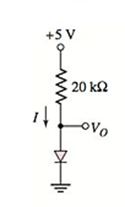
Assuming the diode is in ON state and the modified circuit is:
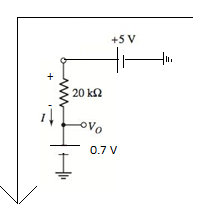
Applying Kirchhoff’s voltage law:
The direction of current is from p-region to n-region of diode. Hence, the assumption is correct.
Applying Kirchhoff’s voltage law:
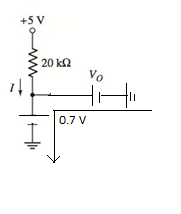
For
The given circuit diagram is:

Assuming the diode is in ON state and the modified circuit is:
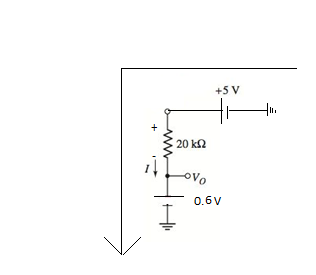
Applying Kirchhoff’s voltage law:
The direction of current is from p-region to n-region of diode. Hence, the assumption is correct.
Applying Kirchhoff’s voltage law:
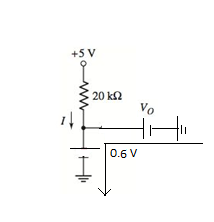
(b).
The values of
Answer to Problem 1.47P
For
For
Explanation of Solution
Given Information:
The given circuit is shown below.
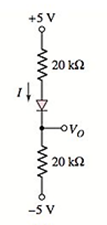
Two values of
Calculation:
For
The given circuit diagram is:
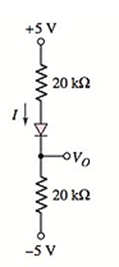
Assuming the diode is in ON state and the modified circuit is:
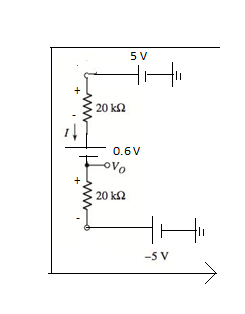
Applying Kirchhoff’s voltage law:
The direction of current is from p-region to n-region of diode. Hence, the assumption is correct.
Applying Kirchhoff’s voltage law in the following circuit:
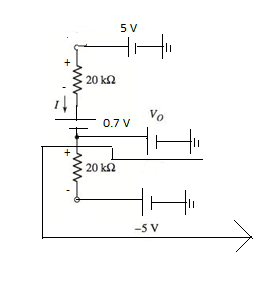
For
The given circuit diagram is:
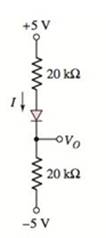
Assuming the diode is in ON state and the modified circuit is:
Applying Kirchhoff’s voltage law:
The direction of current is from p-region to n-region of diode. Hence, the assumption is correct.
Applying Kirchhoff’s voltage law in the following circuit:
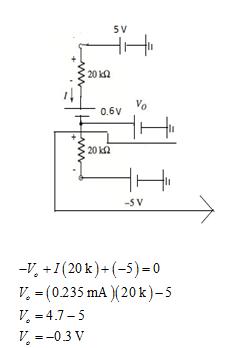
(c)
The values of
Answer to Problem 1.47P
For
For
Explanation of Solution
Given Information:
The given circuit is shown below.

Two values of
Calculation:
For
The given circuit diagram is:
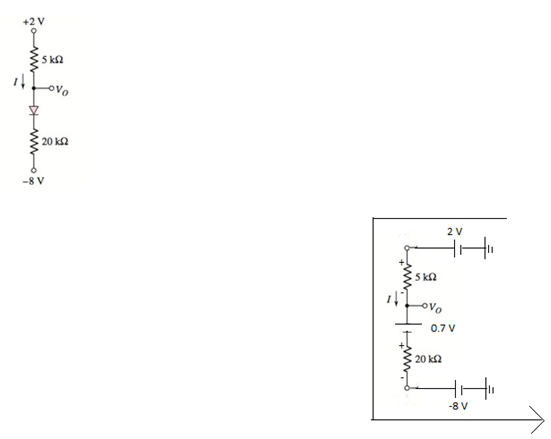
Assuming the diode is in ON state and the modified circuit is :
Applying Kirchhoff’s voltage law:
The direction of current is from p-region to n-region of diode. Hence, the assumption is correct.
Applying Kirchhoff’s voltage law in the following circuit:
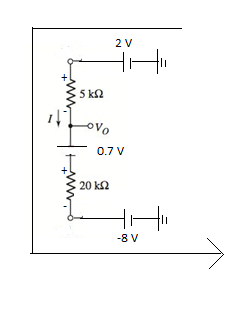
For
The given circuit diagram is:

Assuming the diode is in ON state and the modified circuit is:
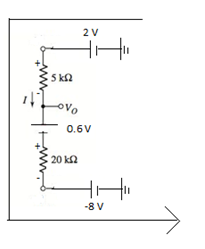
Applying Kirchhoff’s voltage law:
The direction of current is from p-region to n-region of diode. Hence, the assumption is correct.
Applying Kirchhoff’s voltage law in the following circuit:

(d).
The values of
Answer to Problem 1.47P
For
For
Explanation of Solution
Given Information:
The given circuit is shown below.

Two values of
Calculation:
For
The given circuit diagram is:

Assuming the diode is in OFF state. Hence, the modified circuit is:

From the circuit:
In this circuit, the diode is reverse biased, so it is in OFF mode. Hence, the assumption is correct and the value of current
Applying Kirchhoff’s voltage law in the following circuit:
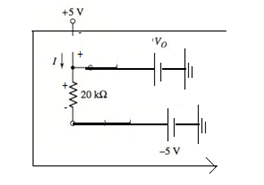
For
The given circuit diagram is:

Assuming the diode is in OFF state. Hence, the modified circuit is:

From the circuit:
In this circuit, the diode is reverse biased, so it is in OFF mode. Hence, the assumption is correct and the value of current
Applying Kirchhoff’s voltage law in the following circuit:
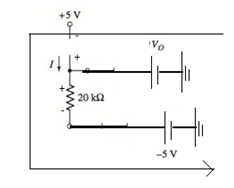
Want to see more full solutions like this?
Chapter 1 Solutions
MICROELECT. CIRCUIT ANALYSIS&DESIGN (LL)
Additional Engineering Textbook Solutions
Java How to Program, Early Objects (11th Edition) (Deitel: How to Program)
SURVEY OF OPERATING SYSTEMS
Experiencing MIS
Elementary Surveying: An Introduction To Geomatics (15th Edition)
Java: An Introduction to Problem Solving and Programming (8th Edition)
Fluid Mechanics: Fundamentals and Applications
- Handwritten Solution pleasearrow_forwardThe E-field pattern of an antenna. independent of , varies as follows: E 0 0° ≤ 0≤ 45° 45°<≤ 90° 90° <8180° (a) What is the directivity of this antenna? Umax 7 why did we use this law Umax = 12 but we divided by 2? In the sent Solution = R 27arrow_forwardThe normalized far-zone field pattern of an antenna is given by (sin cos²) E = 0 00 and 0 ≤ ≤ π/2. 3/22 π elsewhere Find the directivity using (a) the exact expression In the sent soalation Use Prad=2+1 7/2 Pre= 2 + 1 Sco³odo + 5 siño de Where did the 2 Com from?arrow_forward
- Pen and paper solution please with explaination not using chatgptarrow_forwardhowarrow_forwardA four pole generator having wave wound armature winding has 51 slots ,each slot containing 20 conductors,what will be the voltage generated in the machine when driven at 1500rpm assuming the flux per pole is 7mWb Don't use Artificial intelligencearrow_forward
- Need Handwritten solution Do not use chatgpt Or AIarrow_forwardI need a detailed solution to a problem. The far-zone electric field intensity (array factor) of an end-fire two-element array antenna, placed along the z-axis and radiating into free-space, is given by E=cos (cos - 1) Find the directivity using (a) Kraus' approximate formula (b) the DIRECTIVITY computer program at the end of this chapter Repeat Problem 2.19 when E = cos -jkr 0505π $[ (cos + 1) (a). Elmax = Cost (case-1)] | max" = 1 at 8-0°. 0.707 Emax = 0.707.(1) = cos [(cose,-1)] (cose-1) = ± 0,= {Cos' (2) = does not exist (105(0)= 90° = rad. Bir Do≈ 4T ar=2() = = Bar 4-1-273 = 1.049 dB T₂ a. Elmax = cos((cose +1)), 0.707 = cos (Close,+1)) = 1 at 6 = π Imax (Cose+1)=== G₁ = cos(-2) does not exist. Girar=2()=π. 4T \cos (0) + 90° + rad Do≈ = +=1.273=1.049dB IT 2arrow_forwardI need an expert mathematical solution. The E-field pattern of an antenna. independent of , varies as follows: 0° ≤ 0≤ 45° E = 0 45° {1 90° 90° < 0 ≤ 180° (a) What is the directivity of this antenna? (b) What is the radiation resistance of the antenna at 200 m from it if the field is equal to 10 V/m (rms) for Ø = 0° at that distance and the terminal current is 5 A (rms)?arrow_forward
 Introductory Circuit Analysis (13th Edition)Electrical EngineeringISBN:9780133923605Author:Robert L. BoylestadPublisher:PEARSON
Introductory Circuit Analysis (13th Edition)Electrical EngineeringISBN:9780133923605Author:Robert L. BoylestadPublisher:PEARSON Delmar's Standard Textbook Of ElectricityElectrical EngineeringISBN:9781337900348Author:Stephen L. HermanPublisher:Cengage Learning
Delmar's Standard Textbook Of ElectricityElectrical EngineeringISBN:9781337900348Author:Stephen L. HermanPublisher:Cengage Learning Programmable Logic ControllersElectrical EngineeringISBN:9780073373843Author:Frank D. PetruzellaPublisher:McGraw-Hill Education
Programmable Logic ControllersElectrical EngineeringISBN:9780073373843Author:Frank D. PetruzellaPublisher:McGraw-Hill Education Fundamentals of Electric CircuitsElectrical EngineeringISBN:9780078028229Author:Charles K Alexander, Matthew SadikuPublisher:McGraw-Hill Education
Fundamentals of Electric CircuitsElectrical EngineeringISBN:9780078028229Author:Charles K Alexander, Matthew SadikuPublisher:McGraw-Hill Education Electric Circuits. (11th Edition)Electrical EngineeringISBN:9780134746968Author:James W. Nilsson, Susan RiedelPublisher:PEARSON
Electric Circuits. (11th Edition)Electrical EngineeringISBN:9780134746968Author:James W. Nilsson, Susan RiedelPublisher:PEARSON Engineering ElectromagneticsElectrical EngineeringISBN:9780078028151Author:Hayt, William H. (william Hart), Jr, BUCK, John A.Publisher:Mcgraw-hill Education,
Engineering ElectromagneticsElectrical EngineeringISBN:9780078028151Author:Hayt, William H. (william Hart), Jr, BUCK, John A.Publisher:Mcgraw-hill Education,






